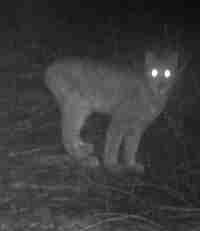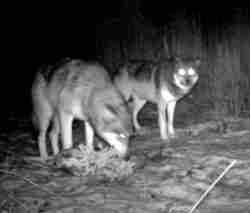When I am not guiding or traveling, you can find me residing in the quirky little fishing village (though some argue it is primarily a drinking village with a fishing problem) of Homer, Alaska. It is a small enough town that when I run errands I must double the estimated time to account for the numerous run-ins with folks I know. There is a lot of pleasant chat about weather, rare bird sightings, ski conditions, and some people ask me if I have checked my game camera recently. It’s a funny thing, I am known in several circles as the “Moose carcass guy.” Some even just call me “gutpile.” Let me explain…
In September of 2009 I got a call from a neighbor friend who knows which trails I frequently hike with my wife. On one of these trails a neighbor had shot a moose to stock up on a winter’s supply of meat. As usual, he carried out only the edible portions of the animal, leaving some of the bones, hide and organs. This “gutpile” as it is called, was right off the trail, and would likely attract grizzly or black bears. I have spent far more than my share of time around bears and I know all too well that you never want to invade the space of a bear who has found a major food source like a gutpile. Despite my better judgment, within 5 minutes I had grabbed a bear deterrent flare (just in case) and my trustee wife and assistant Melissa (who wasn’t really keen on the whole idea) and headed out to put up my game camera on the nearest tree, hopefully before the bears got there.
A game camera, also known as a camera trap, is a 1 foot by 1 foot box that shoots a short video and takes an image when something moves past it and triggers a motion sensor, even in total darkness, with the help of an infrared beam. This is by far the best way to capture the comings and goings of wildlife that would otherwise disappear long before one would have a chance to photograph them. They are invaluable tools used by biologists to determine the presence of endangered wildlife such as jaguars in the Southwestern US, pandas in China, and tigers in India. To view images from WWF”s project documenting rare wildlife in Sumatra using camera traps click here.
As we headed down the trail the ominous sound of two dozen ravens and a handful of magpies, gray jays and bald eagles caught our attention. For a bear this is a dinner-bell, and for a hiker this is the equivalent of a huge red flashing warning sign because bears respond well to dinner bells. I popped the safety cap off of my flare and proceeded with extreme caution, making lots of noise.
Unlike the region of Katmai where I guide bear viewing trips, most bears on the Kenai Peninsula have a fear of people, are nocturnal, and are rarely seen by humans. As I expected there were no bears on the carcass when we arrived, but we didn’t want to linger, so we got to work setting up the camera on a nearby tree. Melissa is a chef with a very well developed sense of smell which is strongly offended by the aroma of rotting moose meat. She fervently proclaimed, her face nearly blue from holding her breath, her eyes scanning the bush for approaching bears, that this was last time she would assist me on a “carcass project” as she called it.
I left the camera up and running and didn’t check it until I returned from my season guiding Churchill polar bear viewing trips in late November. I had to break trail through a few feet of snow to reach the camera. Near the camera the snow was packed down with hundreds of sets of tracks of a variety of animals, many of them very fresh. Brown moose hair was scattered on the icy surface. Even after more than two months this site was still attracting wildlife. I couldn’t wait to see what was on that precious little memory card. Here’s what I got….
The first visitors were of course the ever alert and opportunistic corvids, or members of the jay family (corvidae) which included ravens, magpies and gray jays. The noise of the squabbling scavengers then attracted a mature and an immature bald eagle. The bird activity and the breezy conditions broadcasted the carcass’ location far and wide. A few nights later the first Alaskan brown bear (coastal grizzly) reached the scene and was the first mammal to feed. This appeared to be a mature female, fat and healthy from a summer of gorging on salmon and berries, and carrying a shaggy winter coat. To my surprise, the second visitor was an elusive lynx. These beautiful northern cats are specially adapted to catch snowshoe hares using their proportionately large feet which float atop deep snow. Lynx rarely, if ever, feed on carrion, so it didn’t surprise me that it just took a look around. A few nights later a coyote, a common resident of the Kenai Peninsula, showed up to look for bones and scraps.
The carcass remained untouched for nearly a month before another grizzly arrived. Judging by the larger head in relation to the body size, I estimate this to be a smaller subadult female, probably in her fourth year and recently kicked out by her mother, which I think was the first bear. This younger bear ate what was left, and after playing with the hide, carried it off into the dark forest.
On the 9th of November, a few days after our first snowfall, a pack of magnificent wolves appeared like ghosts from the surrounding wilderness. Locals, like myself, who spend time in the woods know they are out there, traveling like a band of spirits under the cover of darkness, but I have never heard of anyone actually seeing one in this area. We have been chilled by their haunting howls, and often followed their tracks in the snow, but these wolves have learned that if they are to survive on the Kenai Peninsula, they must remain invisible. With the game camera I captured their secret appearance, and even a hint of their silent body language.
This video went “viral” around the 4000 residents of Homer, and many were surprised and excited to see what large carnivores stalk the hills outside of their town after the sun goes down. The results have encouraged several folks to set up their own game cameras. My goal is for the locals in town to realze how lucky they are to still have large predators in their home region, adding character and integrity to the land. In my opinion, without them, the forests would feel empty, flat, and maybe even boring.
I have spent countless hours squatting over game trails in the snow, trying to decipher what animals and what actions preceded my arrival. Are small round dog prints a large coyote or a small wolf? Is the set of round prints dug deeply into the powder left from a lynx or could that be a wolverine? With the freezing and thawing of the snowpack, and drifting snow on the surface, winter tracks can be extremely vague and difficult to distinguish. Life in the boreal forest is largely shrouded in mystery.
A few years ago some regular clients on my Kodiak-Katmai grizzlies expedition from Montana told me about their winter hobby in the forests near Glacier National Park. Like myself, they often ski or snowshoe into the forest in hopes of seeing and photographing elusive wildlife. They most often only see tracks in the snow, leaving their imagination reeling about what goes on during the long, frigid nights when they are back in their cabin. Their solution was to set up remote game cameras in likely habitat which are triggered by movement. They have been wildly successful, capturing cougars, bears and much more.

Checking my game camera on a frigid night in December- it was so cold, around -20 I guess, the thermometer went haywire and read 121
The next Christmas I ordered myself a Moultrie game camera, figured out how to use it, loaded it with a fresh memory card and rechargeable D batteries, and set out on my snowshoes to finally answer some of the questions that loom in my mind when I stare out at the wild boreal forest valley that runs down from our home. My understanding of the habits and abundance of the forest’s elusive denizens has expanded greatly. To me it is yet another non-consumptive hobby which gets me out in the wilderness, teaches me a few things, and helps me appreciate the natural side of our world. Here are few more videos I have collected over the last few years.
Due to the possibility of bears visiting my camera, I had to invest in a metal “bear box” which helps to keep bruins from ripping my camera off its tree. This black bear proved that this was a wise investment!
I was lucky enough to get this beautiful footage of a lynx in broad daylight. Notice how the cat sprays a bush in the middle of the clip.






























Wow. I’m so jealous. I want a Lynx walking around in my backyard. Beautiful.
Awesome! Thanks for sharing. Would find any footage you take of animals interesting so please upload all you have.. – Adrian Meli
Brad, thank you for for sharing your most interesting adventures.. so along someday I hope to go along on one! But you are revealing way too many things that make our hole-in-the-wall so special. Don’t tell where you live! Just keep it a secret!
Wow! Amazing footage Brad!
Brad, you have a small zoo around you! Birds, coyotes, wolves, black bears, grizzlys and Lynx. We’re still talking to incredulous folks about our trip to Katmai. Great memories.
Nice Brad!!!! Hope Homer’s treating you well!!!
as always, loving the wildlife/game camera footage + gear talk!